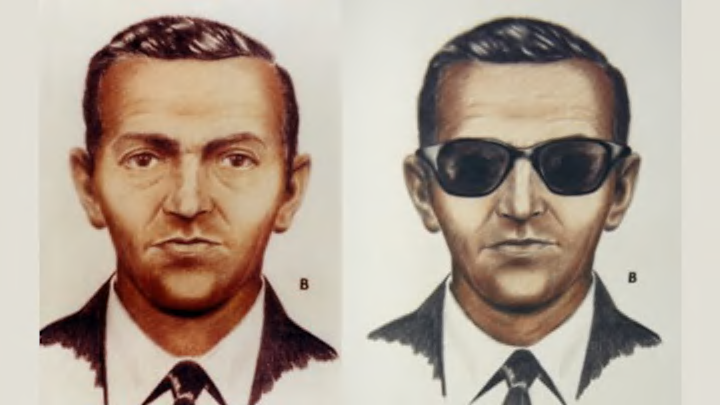Just before Thanksgiving 1971, a man identifying himself as Dan Cooper bought a $20 one-way ticket on Northwest Airlines flight 305 from Portland to Seattle. He was said to be nondescript—just a businessman with a briefcase in his mid-forties who ordered a bourbon and soda and smoked a cigarette.
Once in the air, Cooper passed the flight attendant a note written in all caps, which read “I HAVE A BOMB IN MY BRIEFCASE. I WILL USE IT IF NECESSARY. I WANT YOU TO SIT NEXT TO ME. YOU ARE BEING HIJACKED.” He had the stewardess tell the captain that he wanted $200,000 in $20 bills and four parachutes. The FBI consented to this, and allowed the money and parachutes to be exchanged for the 36 passengers once the plane landed in Seattle.
Cooper’s next demand was for the plane to fly to Mexico at an altitude of under 10,000 feet. The two pilots and flight attendant on that flight were told to stay in the cockpit, and less than an hour into the flight, Cooper jumped out of the back of the plane somewhere over the Cascade mountains. It was raining and pitch-black, and he has never been seen since.

The FBI immediately began searching for Cooper, and at one point police questioned an Oregon man named D.B. Cooper who had a minor record. He was quickly dismissed as a suspect, but a wire agency error had the United Press print “D.B. Cooper” as the hijacker’s pseudonym, and soon, the world knew the jumper by that name.
Somehow, Cooper disappeared without a trace. Officials combed the woods, but no trace of a body, or of the parachute or other personal items, was found. Nine years later, an 8-year-old boy was digging in the sand along the Columbia River near Vancouver, Washington, and found $5800 worth of $20 bills, still packaged and serialized as they were when they were handed over to Cooper. These bills are still the only concrete evidence that has been found regarding Cooper or his possible fate.

In 2007, the FBI reopened the case, saying that with new technologies—such as DNA testing—they hoped to catch their man. They shared their vault information and revealed that they’d considered more than 800 suspects in the years immediately following the hijacking. A paleontologist and scientific illustrator even came on board, and in 2011 they posited the theory that Cooper took his alias from a French-language comic book about a Canadian Air Force pilot. The FBI even said they had their “most promising lead” yet. But nothing came of it, and the FBI closed the case again in 2016.
Over the years, Cooper became a myth and a pop culture point of interest. His name has been mentioned or his story alluded to in everything from local folk songs like Todd Snider’s “D.B. Cooper,” to mainstream rock-rap like Kid Rock’s “Bawitdaba.” He’s been a subplot or punchline on shows like Archer, Numb3rs, Leverage, 30 Rock, Breaking Bad, and Mad Men. (Viewers theorized that Don Draper would reinvent himself once again in the series finale as the perhaps not-so-far-fetched polite, well-dressed businessman ordering a bourbon and passing the flight attendant a note. That’s not what happened.) One of the $20 bills that was found in 1980 even wound up on an episode of Pawn Stars (it sold for $1600).
Now, there’s new evidence to consider. Two years ago, according to Axios, a D.B. Cooper YouTuber named Dan Gryder discovered “a modified parachute on the property of a former suspect” named Richard McCoy II, who had pulled off a similar heist in 1972. McCoy was captured and sentenced to 45 years in federal prison, but escaped; he was killed by police in a shootout in 1974. Per Axios, the FBI reached out to Gryder and traveled to the North Carolina property owned by McCoy’s family to take “the parachute, a harness and a skydiving logbook into evidence.” Gryder—who uncovered the evidence in a barn on the property—told Cowboy State Daily it was a “one in a billion rig” that seemed to match the modifications made by skydiver Earl Cossey in response to Cooper’s demands.
D.B. Cooper’s case remains the only unsolved commercial airplane hijacking in U.S. history.
Discover More Stories About Mysteries:
A version of this story ran in 2015; it has been updated for 2024.
